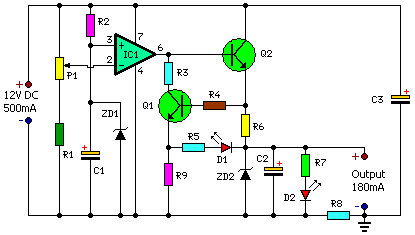- USB Powered Mobile Phone Battery Charger
- NiMh and NiCd Battery Charger Circuit
- NiCd Battery Charger With Reverse Polarity Protection
- Mobile Phone and iPod Battery Charger Circuit
- Mobile Phone Travel Charger Circuit Diagram
- Mobile Phone Battery Charger Circuit
- Mobile Cellphone Battery Charger Circuit
- Low Cost Universal Battery Charger Schematic
- Lithium-Polymer Peak Charger
- In-Car Charger And Switcher Circuit For SLA Battery
- Battery Charger Regulator
- A Friendly Charger Schematic for Mobile Phones
- 12 Volt Car Battery Charger Circuit Schematic
- Versatile Micropower Battery Protector
- Flashing-LED Battery-Status Indicator Circuit
A Friendly Charger Schematic for Mobile Phones
Description
Most mobile chargers do not have current/voltage regulation or short-circuit protection. These chargers provide raw 6-12V DC for charging the battery pack. Most of the mobile phone battery packs have a rating of 3.6V, 650mAh. For increasing the life of the battery, slow charging at low current is advisable. Six to ten hours of charging at 150-200mA current is a suitable option. This will prevent heating up of the battery and extend its life.
Circuit diagram:
Parts:
- P1 = 10K LOG
- R1 = 1K
- R2 = 1K
- R3 = 1K
- R4 = 1K
- R5 = 3.3K
- R6 = 16R/2W
- R7 = 220R
- R8 = 3.3R
- R9 = 1K
- C1 = 470uF/25V
- C2 = 10uF/25V
- C3 = 1KuF/25V
- D1 = Red LED
- D2 = Green LED
- Q1 = BC547
- Q2 = BD677
- ZD1 = 12V/1W
- ZD2 = 5.6V/1W
- IC1 = CA3130
The circuit described here, provides around 180mA current at 5.6V and protects the mobile phone from unexpected voltage fluctuations that develop on the mains line. So the charger can be left ‘on’ over night to replenish the battery charge. The circuit protects the mobile phone as well as the charger by immediately disconnecting the output when it senses a voltage surge or a short circuit in the battery pack or connector. It can be called a ‘middle man’ between the existing charger and the mobile phone.
It has features like voltage and current regulation, over-current protection, and high- and low-voltage cut-off. An added specialty of the circuit is that it incorporates a short delay of ten seconds to switch on when mains resumes following a power failure. This protects the mobile phone from instant voltage spikes. When short-circuit occurs at the battery terminal, resistor R8 senses the over-current, allowing Q1 to conduct and light up D1. Glowing of D2 indicates the charging mode, while D1 indicates short-circuit or over-current status.
The value of resistor R8 is important to get the desired current level to operate the cut-off. With the given value of R8 (3.3 ohms), it is 350 mA. Charging current can also be changed by increasing or decreasing the value of R7 using the ‘I=V/R’ rule. Construct the circuit on a common PCB and house in a small plastic case. Connect the circuit between the output lines of the charger and the input pins of the mobile phone with correct polarity.
